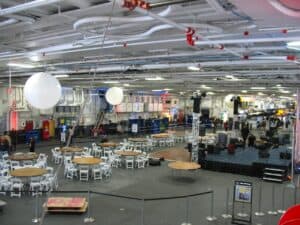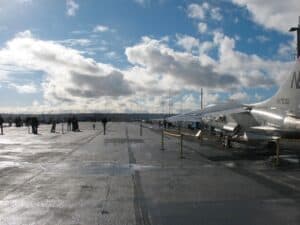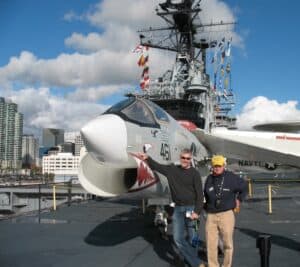Believe it or not, the Right and the Left are at it again. Among other things we’re squabbling over that old saw, how and where to spend our tax dollars. We’ve got a problem and it’s called debt, and it just keeps getting bigger every day.
The solution is up for debate. Not surprisingly the Right is intent on shredding the social safety net, while the Left is hungrily eyeing Defense.
But as I stood in the War Room of the USS Midway, an aircraft carrier anchored in San Diego, it occurred to me that budget cutting is only one way to save money, another way is to be smart about how you spend it in the first place.

The War Room aboard the USS Midway was the command and control center for Operation Desert Storm, one of America’s finest moments.
A Blueprint for Efficiency
One of the most underrated events in American history is the assembly of the Gulf War Coalition during Operation Desert Storm in the Gulf War of 1991. This masterstroke by then President George H.W. Bush involved bringing together 34 nations, including nine Middle Eastern countries, in a concerted effort to push Saddam Hussein out of Kuwait. And it worked.
The operation was orchestrated from the War Room of the USS Midway in the very place I was now standing. Here, pinned to the walls, are the very same Persian Gulf battle maps that guided coalition forces in the assault.

Locked in the brig aboard the USS Midway. A tour of the ship reveals five levels of this “City at Sea” including the jail.
Saddam didn’t know what hit him. The war which had taken five months of careful planning and preparation was over in six weeks. The brevity and effectiveness of the operation saved tens of thousands of lives and billions of dollars. It was a model of efficiency, a blueprint for how future wars could be fought.
Sadly, however, its lessons were lost on Bush’s son, George W. Bush, whose own Middle East exploits were hasty, poorly planned and wasteful, costing lives and treasure over the course of many years.
There’s more than one way to economize.
How to Treat a Drunken Sailor
Still, as anybody in business knows, you’ve got to spend money to make money. The trick is to spend it wisely. And as everybody on both sides of the political aisle knows, the United States had been spending money like a drunken sailor. The question is what to do about it.
Aside from extracting ourselves from fruitless wars that have been pouring money down the drain for nearly two decades, liberal cost cutters would like to pare defense spending still further. Naturally, the Right is getting its collective back up.

Crew quarters for enlisted men aboard the USS Midway were spartan. These are the bunks. Talk about economizing!
The tired old argument that any cut in defense spending impairs our defensive capability overlooks one of the guiding principles of conservative economic thinking as applied in every other realm, that which says sound fiscal policies will be free to emerge once institutionalized waste is cleared out of the way. And, as any serviceman will tell you, the military has long been a hotbed of institutionalized waste.
This is not unique to the American military. Armies by their very nature are sprawling bureaucracies with command and control structures that tend to lock in incompetence. A smooth running military is not one that seeks to eliminate bureaucracy (that would be folly) but one that tirelessly seeks to root out inefficiencies. And in this regard the US military is better than most.

The hangar deck is an enormous indoor mid-level space more than three football fields long housing various aircraft as well as flight simulators, a theatre, a café, restaurant and gift shop.
Among the four branches of service, the Navy can be pointed to as the best in this regard. Not coincidentally, the Navy also has also shown a willingness to make tough cuts when necessary.
Wielding the Budget Ax Like a Scalpel
At the end of World War II the United States boasted the largest navy in the world with more than 6,700 ships in its command. Five years later, the Navy had trimmed its battle forces by more than 90% to 634 active ships. But what the Navy lost in sheer numbers it made up for in greater efficiency.

A little boy tries his hand at a radar station that once swept the sky for Saddam’s air force prior to the allied invasion that liberated Kuwait. The war was over in six weeks.
The new class of aircraft carrier, for example, displaced 45,000 tons compared to 33,000 tons by its immediate forebear, and accommodated 130 aircraft, compared to just 90. This new carrier class was named after its inaugural vessel, the Midway, the ship I was now standing on in San Diego harbor.
The USS Midway, and the sparkling new carrier class it represented, was launched in March of 1945 at the end of World War II. The Navy got its use out of it.
For the next 47 years the Midway patrolled the world’s oceans, seeing action in Laos, Taiwan and Vietnam where it participated in the evacuation of South Vietnam in 1975. In 1981 the Midway showed up in the Arabian Sea to monitor developments during the American hostage crisis in Iran and then sailed south to rescue 17 survivors of a downed civilian helicopter in the South China Sea. But Midway’s finest moment came in 1991 during the Gulf War.

The 900 foot long runway on the deck of the USS Midway could launch one fighter jet every two minutes, a swarm of heavily armed aircraft.
A Finely Tuned Watch
A tour of the USS Midway is eye-opening in a number of ways. If you’ve never been aboard an aircraft carrier, you can’t help but be impressed by the detail and extent of the accommodations aboard this “city at sea”. In addition to the crew quarters, superstructure, engine room and mess, you can see the sick bay, laundry room, officer’s mess, chapel and brig. And that’s just for starters.
The hangar deck of the Midway is an enormous indoor mid-level space more than three football fields long, housing various aircraft as well as flight simulators, a theatre, a café, restaurant and a gift shop. Step upstairs to the flight deck and you’ll be awe-struck.

Tour guides aboard the USS Midway are former sailors who relate with enthusiasm the experience of having served at sea. Here Jim makes the all clear signal.
More than 900 feet long, this enormous shipboard runway did the job the carrier was built for, launching 17,000 pound planes like the F-8 Crusader into the air by way of a powerful steam catapult that took plane from zero to 160 mph in 2.5 seconds.
Obviously, such awesomely powerful and precise mechanisms required highly-trained specialists for their operation. The navy furnished them, as well as thousands of others at every grade level, making the ship and its multitude of operations as smooth running as a finely tuned watch. Fully complemented, the Midway was home to more than 4,000 men, working in concert with remarkable efficiency, not unlike like the coalition forces that came together to bring the Gulf War to its swift and effective end.

Standing by an F-8 Crusader on the deck of the USS MIdway with former Navy man Jim. The F-8 was a dogfighter that set records for speed and climb.
Targeting the Objective
When capably led and properly executed, a military operation is something that saves lives and money instead of wasting them. But for that to happen those in power must deal with realities. Incompetence and inefficiencies must be identified and weeded out. Curiously, these are precisely the same requirements needed for effective budgeting.
Judging by what I saw aboard the USS Midway, few organizations are better equipped to reduce costs by achieving efficiencies than the US Navy. Its ships run with admirable precision and it gets maximum use out of its assets. To ask them to cut costs is a challenge to which they can rise, if we only ask them.

Beware of Jet Blast. Walking out the wrong door on the USS Midway back in the day could get you a face full of rocket fueled back wash.
First, however, the nay-sayers will have to step out of the way. Every cut in defense spending does not impair our defensive capabilities. Ironically, they may actually enhance them.
As proven by the Gulf War, a lean and effective military coordinating with allies, working from a sound plan with clear objectives can achieve a net savings in lives and money.
On the other hand, pretending you’re succeeding when you’re failing, being fuzzy about your objectives, ignoring and protecting incompetence, and going it alone with chest beating bravado, gets you into long, wasteful quagmires like Iraq, Afghanistan and Vietnam. Our wallets should be closed to this kind of profligacy, no matter how frightened or outraged we might be. It’ll save us more in blood and treasure than all the flag waving and drum beating we can muster.
Check it out…
 USS Midway Museum
USS Midway Museum
910 N. Harbor Dr.
San Diego, CA 92101
(619) 544-9600
Website
Previous stop on the odyssey: Palm Springs, CA //
Next stop on the odyssey: Silicon Valley, CA
Image credits:
All images by Malcolm Logan, except aerial view of USS Midway, Public domain



